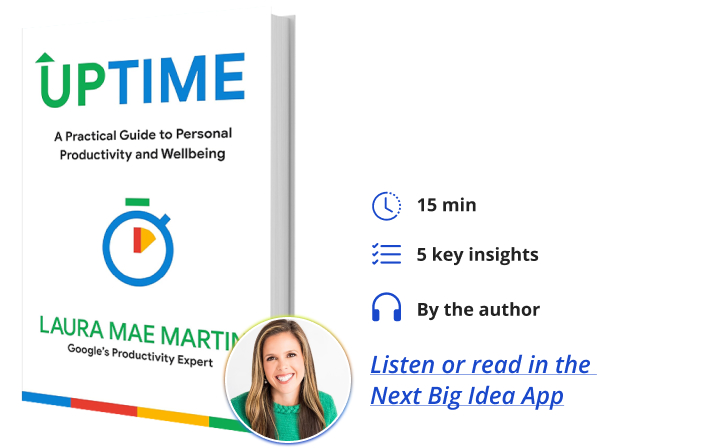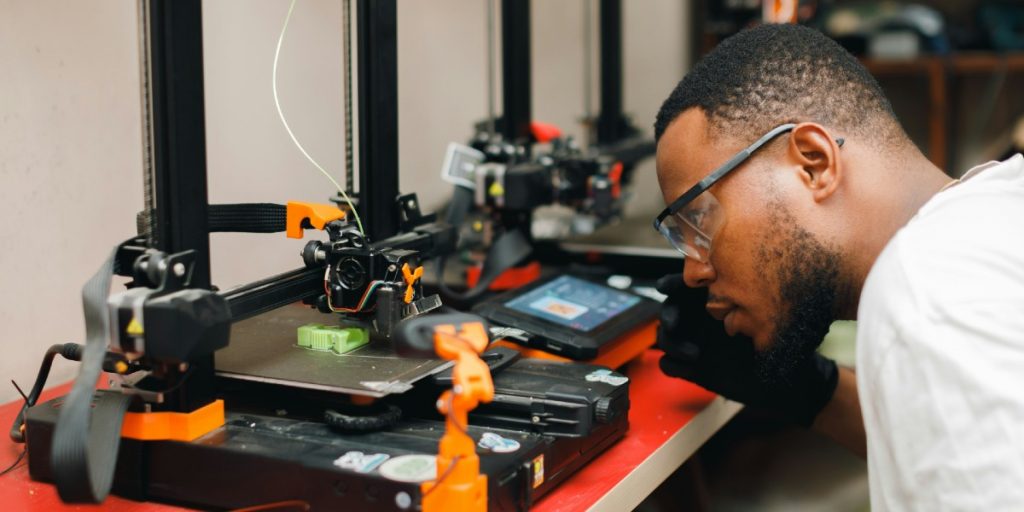Laura Mae Martin is Executive Productivity Advisor at Google. She coaches Google’s top executives on the best ways to manage their time and energy and sends out a weekly productivity newsletter that reaches over 50,000 employees. She holds a Bachelor of Science in business administration from the University of North Carolina at Chapel Hill.
Below, Laura shares five key insights from her new book, Uptime: A Practical Guide to Personal Productivity and Wellbeing. Listen to the audio version—read by Laura herself—in the Next Big Idea App.

1. Do your email like you do your laundry.
Let’s forget email for a second and talk about something most people understand more— laundry. What if doing your laundry looked like this: you open the dryer door and pick out one shirt. You fold that shirt and walk all the way upstairs and put it in your dresser, then walk back downstairs to the dryer. You find another shirt, fold it, walk upstairs to the dresser, and then walk back downstairs to the dryer. You find a pair of pants, and it still seems a little damp, so you throw it back in with the other dry clothes. You find one sock and don’t really feel like hunting for the other sock, so you walk it upstairs, put it in your sock drawer, and come back downstairs. You find a pair of pants, but it’s the same pair of damp pants you already touched, so you put them back in again.
You panic every time you need a specific piece of clothing because you don’t know if it’s in the dryer with all those other clothes, if you forgot to wash it, or if you put it away. All throughout the day, you check your dryer even if you don’t have time to fold just to remind yourself how much laundry you have. At the end of the day, you decide you don’t really feel like emptying the dryer completely, so you just turn back on the cycle and start over when new clothes are added from the washer.
How inefficient is this? Talk about a waste of energy! It’s a terrible, stressful way to do laundry. Yet this is how many people do email. Wet clothes are thrown back in with the dry clothes (marked as unread). The dryer is never emptied (achieving inbox zero). People look at their full dryer multiple times throughout the day, reminding themselves there’s a big mess in there that is not taken care of (checking email fifteen or more times a day without clearing it). They wake up in the middle of the night having no idea if they answered an email or missed something important in their inbox (where is that pink shirt?). So, what can the laundry metaphor teach us about managing our email?
“We can treat sorting, reading, and answering emails as different activities.”
Instead, we can do a few things. We can treat sorting, reading, and answering emails as different activities. We decide we are doing email just as we decide we’re doing laundry, and set aside specific time for it instead of poking around constantly. We can address everything in the inbox at one time until we’re done, like emptying the dryer. We can sort it into piles. For example, folding/hanging/socks that need matching are the equivalent of responding/reading/revisiting an email. We can do all of a pile at once and get batch tasking benefits. We can touch emails two times maximum (the first time we sort it and the next time we reply/fold it), minimizing the energy points we spend on each email. We should treat sorting/reading/answering as distinct activities and not intermix them (instead of folding one shirt, then hanging one dress, then matching socks).
Finally, even if we don’t have time to hang all the clothes (respond to all the emails), we have a pile of clothes to hang, and if we’re missing the green shirt (that one email from our boss), we know exactly where it is and that it’s been touched once. This simple mental shift, followed by a change in the structure of your inbox, can make you feel completely on top of your email.
2. Designate hot spots and not spots.
Why do some people listen to the same piece of classical music to focus or to fall asleep? Some authors write their entire book in the same seat of the same coffee shop. Conversely, why did so many of us have difficulty switching to a home office at the beginning of the pandemic? It’s all because of the same thing: state dependency. State dependency refers to the fact that our brains take in so much more than just what we’re doing. They have context clues like where we are, what we smell, and what we hear—information stored in our brains that we associate with what we are thinking about or doing.
When we recognize that our brain is associating certain places with certain tasks, we can manipulate that tendency to our advantage. The reason it took no time at all to slip into “work mode” when in the office every day is because so many other conditions were lined up before you even opened your computer: your commute, your desk, your office, your chattering cubemates, your favorite coffee mug. All of these were cues that your brain was consistently associating with work daily. They were “greasing the wheel” before you even sat at your desk.
You can use this human inclination to your advantage by creating physical hot spots for certain types of work. This can be done whether you have multiple locations for hybrid work or even if you work from the same location every day, like the home or office. You create task and location patterns. For example, I always do my expenses on the big comfy window chair in my office. I always read product design documents at a coffee shop near my house on work-from-home days. I always start the day reading industry news on my phone on the front porch. I always respond to emails with my cup of coffee at my desk first thing in the morning.
“When we recognize that our brain is associating certain places with certain tasks, we can manipulate that tendency to our advantage.”
Similarly to your “hot spots” for certain tasks, you want to create “not spots.” Not spots are safe places for your brain where you never do work or difficult tasks, just relax. When my husband and I first moved into our new house with our children, we had this awkward side area of our primary bedroom that I had no idea what to do with. It wasn’t big enough to be a total sitting area but not small enough just to put a table. Eventually, we moved a chair-and-a-half there with some blankets, a bookshelf, and a coffee machine. It quickly became known by my kids as the “cozy corner.”
The cozy corner is where I finish a cup of coffee before my kids wake up. It’s where I read books and magazines or meditate. It’s where my daughter meets me in the morning when she wakes up, bringing a book of her own. There’s no clock in the cozy corner (I set alarms with my phone across the room if I need to know when it’s time to do something). I often catch myself wanting to bring my laptop there to finish a few emails or to bring my phone to scroll on social media, but I resist because never once in that chair has my brain actively thought about work, stress, or anything but relaxation. I associate that corner with my kids, reading, relaxing, and being cozy. Why would I ruin that? It’s so easy for me to unwind in that corner, which is why I love it.
3. Prioritize downtime.
Uptime in the computer world is any time a machine is on, operational, and productive. I define it as the same in your world. Finding your uptime is that feeling of being in the flow, on top of things, productive, and well. It’s the feeling of calm accomplishment.
Many people think of downtime as the opposite of uptime, but they go hand in hand. Just like your computer needs to shut down, reboot, and restart to avoid burnout, you need the same! We require those times of working out, walking the dog, vacations, breaks between meetings, and times without devices to relax, refresh, and process information and ideas. Without those breaks, we cannot sustain uptime.
Downtime is also routinely cited as the best time for creativity. Your greatest ideas are more likely to come to you while on a walk or cooking dinner than they would during your tenth meeting of the day. You have to allow for downtime in your schedule to fuel your own propensity for big-picture thinking and inspiration.
4. Find your Power Hours, then protect them.
There is so much buzz around time management. We want more time, need more time, and there’s never enough time. Very often, we block some time on our calendar—say 3 p.m. to 4:30 p.m. to work on a new project. We wrap up a meeting and sit down around 3:08. We check our email real quick, and it’s 3:15. Until a chat comes in, and now we pull up another tab. It’s 3:45, and we really need to get started, but we’re feeling low energy. We do one slide and realize we forgot to respond to something that feels easier to work on. We do that, and soon it’s 4:15. Now we only have 15 minutes; is it even worth getting started on that project? We actually made the time for that project, but was 3 p.m. to 4:30 p.m. the right time?
“The important thing is that it’s not just any time, it’s when I feel like doing that type of work.”
Most of us have a general sense of our Power Hours—the daily time slot we naturally find ourselves more focused, alert, and strategic. If you know you’re not a morning person, then you know your Power Hours likely do not fall between 7 a.m. and 10 a.m. To specify what those hours are, you can keep a productivity journal at your desk, and any time you’re feeling particularly in the zone, take note of what time it is. You’ll start to see a pattern. You can also ask yourself, “If I had a full day tomorrow to get work done and I could structure it however I like, when would I set aside time to do focused work?” That slot you choose is probably your Power Hours.
Once you’ve identified your Power Hours (mine are 9 a.m. to 11 a.m.), you want to do whatever you can to keep those hours blocked for strategic, focused work. Clear them of low-energy meetings, administrative tasks, or catch-up chats. Even blocking these hours one to two days a week can make a huge difference in how “on top of it” you feel. I keep my Power Hours blocked every single Wednesday and Friday without exception. I never get behind or feel stressed because I always know that I have some time to really get things done each week. The important thing is that it’s not just any time, it’s when I feel like doing that type of work. Blocking 3 p.m. to 5 p.m. two days a week would not have the same effect on my productivity because I would not do my best work in that time slot. Slotting that project in a time that is not during Power Hours does not get results. Being intentional about your Power Hours is how you match both time and energy to ensure excellence in execution.
5. Plan for Future You.
Psychology tells us we all have a disconnect between our current and future selves. When we try on clothes at the store, why do we sometimes think, I don’t love it, but I could maybe see myself wearing it later? Won’t we be the same person later who also won’t want to wear it now? When we’re asked to schedule a meeting on Monday at 8 a.m., the day we’re returning from a two-week vacation, we think, “Sure!” We add it to our calendars, but we don’t envision Future Us that day trying to make that happen. We schedule six big meetings in a day back to back, but are we walking through how that future version of us will feel with that schedule?
Instead of planning for who we are now, we want to constantly plan for our future self. If we ask, “What will Future-Me wish I had done right now?” we find our schedules smoother, our priorities crisper, and our output more effective. I challenge executives to ask themselves these questions: What will future you wish you had scheduled or not scheduled after that four-hour meeting block next week? What will end-of-year you wish that you had spent more or less time on? What will parent-with-grown-up-kids-you say that you wished you had prioritized more during these early years?
To listen to the audio version read by author Laura Mae Martin, download the Next Big Idea App today:































